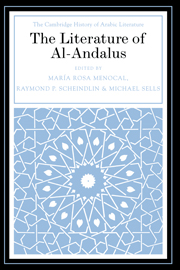9 - The qasida
from PART II - THE SHAPES OF LITERATURE
Published online by Cambridge University Press: 28 May 2012
Summary
The qasida belongs to those crucial areas in which the Andalusian literary universe is an extension of the classical Arabic one. The qasida is a formal multithematic ode addressed to a member of the elite in praise, in admonition, or in quest of support. Poets and scholars traveling in both directions imported the Eastern heritage into Andalusia, and by the fourth/tenth century, the distant province became the home to centers of patronage that attracted even Eastern poets. The affiliation manifested itself in Andalusian emulations of famous Eastern qasidas by Abū Nuwās, al-Mutanabbī, and others. Only as a second step did Andalusians give up vying with their Eastern cousins to find their own paths, as evidenced by the emergence of the muwashshah. At first excluded from the poets’ official collected works (diwans), the muwashshah gradually conquered high literature, eventually rivaling the qasida in its own sphere of panegyric. But while giving due credit to Andalusian self-assertion within the Arabo-Islamic literary universe, one must also recognize that al-Andalus first earned its legitimacy by excelling in qasida poetry.
Not surprisingly, the study of Andalusian Arabic literature has been dominated by the study of the distinctively Andalusian zajal and muwashshah or the question of literary influences between Muslims, Jews, and Mozarabs. As a result, research on classical poetry in Arabic, a major unifying field in this culture, has suffered (Schmidt 66). Moreover, scholarship on classical Andalusian poetry has tended to focus on genres perceived as typically Andalusian, such as nature poetry, or on personalities differing from the mold of the courtier-poet, such as the doomed last Abbadid king, al-Mu‘tamid, and the independent Valencian aristocrat Ibn Khafāja (Jayyusi, Legacy 317–97; al-Nowaihi; Scheindlin, Form).
- Type
- Chapter
- Information
- The Literature of Al-Andalus , pp. 211 - 232Publisher: Cambridge University PressPrint publication year: 2000
References
- 1
- Cited by



